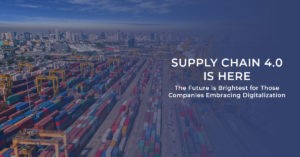Industry 4.0 Superb Transforming Supply chain Trends
| Industry 4.0 is revolutionizing supply chain with trends like IoT, AI, and automation, optimizing operations, enhancing visibility, and enabling predictive analytics. |
We are witnessing the dawn of the fourth industrial revolution. Industry 4.0, as it is sometimes called, is the result of decades of digital innovation, research, and development. Industry 4.0 is characterized by the use of emerging technologies like the Internet of things (IoT), machine learning (ML), artificial intelligence (AI), and the use of Big Data in advanced data analytics.
This digital revolution and its groundbreaking effects on production and manufacturing have transformed supply chains across businesses and industries. Industry 4.0 is centered around leveraging global networks of machines (albeit in a controlled setting), to create cyber-physical systems that allow these machines to operate autonomously, exchanging information, and controlling each other.
Essentially creating a smart factory and bringing about a future of growth and efficiency through the new paradigm of Supply Chain 4.0.
By definition, smart factories are flexible and embrace adaptation for changing industry trends and demands. Smart factories are constructed in ways that their operations can be monitored, controlled, coordinated, and integrated via a computing, communication core, making it a functioning cyber-physical system (CPS).
The CPS is developed in ways that integrate computing and communication with physical processes for the addition of new capabilities
Industry 4.0 has not only transformed the structure of supply chains, but it has also changed the way we view supply chains. Industry experts and market analysts have been observing a dramatic shift away from traditional sequential strategy hierarchies.
Supply chains and the process of Supply chain management are no longer a linear set of activities starting from vision to execution. With the introduction of Industry 4.0 technologies, widespread data availability, and increasingly sophisticated data analytics, what used to be a linear process has since become interconnected, iterative, and dynamic, networks of systems and practices. Sometimes referred to as Digital Supply Networks (DSNs)
DSNs consolidate information from a diverse range of sources to drive production and distribution and can drastically change the manufacturing’s competitive landscape.
Interconnected systems like DSNs can make the integration of ecosystem partners a smooth process. Over time, such systems can achieve their optimal state and allow the creation of a world that is virtual but mimics and informs the physical.
By using a combination of the traditional and the new, DSNs can provide comprehensive views of the supply network and rapid responses to unanticipated changes and challenges.
Industry 4.0, also known as the fourth industrial revolution, is transforming supply chains in significant ways. One of the key trends is the integration of Internet of Things (IoT) technologies, where physical objects are connected and share data. IoT devices embedded in products and equipment enable real-time monitoring, tracking, and analysis of supply chain operations.
This enhances visibility and enables proactive decision-making. Another trend is the adoption of artificial intelligence (AI) and machine learning algorithms. These technologies can analyze vast amounts of data to identify patterns, optimize processes, and predict demand and supply fluctuations.
Automation is also a crucial aspect of Industry 4.0. Robotics and autonomous systems are being deployed in warehouses, manufacturing facilities, and transportation to streamline operations, reduce errors, and improve efficiency.
Furthermore, the use of digital twins, virtual replicas of physical assets, is gaining traction. These virtual models help simulate and optimize various scenarios, enabling companies to test and refine their supply chain strategies before implementation. Overall, Industry 4.0 is reshaping supply chains by leveraging advanced technologies to optimize operations, enhance visibility, and enable predictive analytics, ultimately leading to improved efficiency and customer satisfaction.
In this volatile, ever-changing world, Supply Chain 4.0 is not just a trend within the industry, it is an irreversible, cultural shift. Successful companies of today and tomorrow will have to take a proactive approach to their supply chains to remain viable regardless of major events or business occurrences outside of their control.









































































